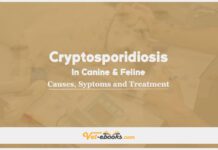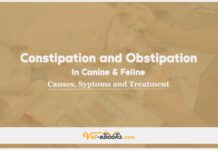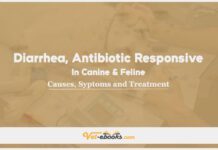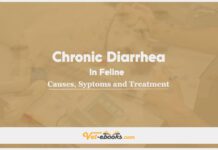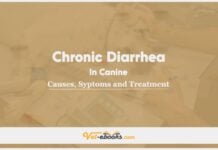Dyschezia and Hematochezia In Canine and Feline: Causes, Symptoms and Treatment
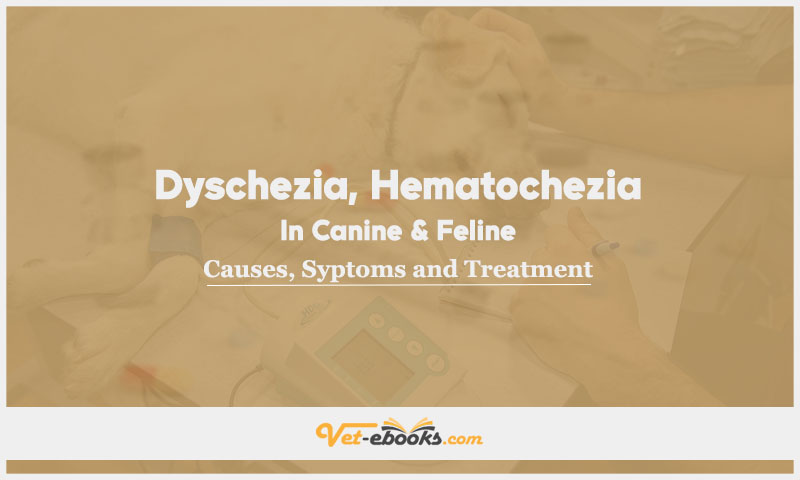
Overview
- Dyschezia: painful or challenging feces.
- Hematochezia: presence of bright crimson blood in or on the feces.
Causes of Dyschezia and Hematochezia In Canine and Feline
Causes
Rectal or Anal Disease
- Stricture or spasm.
- Anal sacculitis or anal abscess.
- Perianal fistulae.
- Foreign bodies in the rectum or anus.
- Pseudocoprostasis.
- Rectal prolapse.
- Trauma (bite wounds).
- Neoplasia (adenocarcinoma, lymphoma, and anal sac tumors).
- Rectal polyps.
- Mucocutaneous lupus erythematosus.
Colonic Disease
- Neoplasia (adenocarcinoma, lymphoma, and other tumers).
- Idiopathic megacolon (felines).
- Inflammatory bowel disease.
- Infections caused by parasite agents.
- Colitis resulting from dietary-responsive enteropathy.
- Constipation.
Extraintestinal Disease
- Fracture of the pelvis or pelvic limb.
- Prostatic disease.
- Perineal hernia.
- Intrapelvic neoplasia.
Risk factors
- Consuming hair, bone, or other foreign substances causes constipation and subsequent dyschezia.
- Environmental variables (unclean litter pans or rare opportunities for outdoor excursions).
Pathogenesis of Dyschezia and Hematochezia In Canine and Feline
outcomes arising from inflammatory, infectious, or neoplastic disorders that impact the colon, rectum, or anus.
Symptoms (History & Physical Examination) of Dyschezia and Hematochezia In Canine and Feline
History
- Vocalizing and whimpering while excreting waste.
- Tenesmus.
- Dyschezia is often accompanied by fewer bowel movements. This can cause animals to develop constipation or obstipation.
- Mucoid, bloody diarrhea with a significant increase in frequency and a decrease in fecal volume are symptoms of colitis.
- The correlation between scooting behavior and anal gland infection or impaction.
- Distinguishing between hematochezia resulting from colitis and hematochezia resulting from a colorectal mass is important.
- Patient histories associated with these conditions are significantly distinct; do a rectal examination to further distinguish between these two disorders.
Physical Examination
- Rectal examination (firm stools, diarrhea suggesting colorectal disease, colorectal masses, thickening of the anorectal region, strictures in the rectum or colon, enlargement or pain in the anal sacs, prostatomegaly, or perineal hernias).
- Fistulous tracts in the vicinity of the anus are a manifestation of perianal fistulae.
- Presence of matted hair and feces, causing anal blockage with pseudoprostasis.
Diagnosis of Dyschezia and Hematochezia In Canine and Feline
1- From History and Physical Examination
2- Diagnostic Procedures
CBC/BIOCHEMISTRY/URINALYSIS
- Often unremarkable.
- Regenerative anemia can be a symptom of acute blood loss, whereas different levels of chronicity can be associated with iron deficiency and nonregenerative anemia with microcytosis or hypochromia.
- Inflammatory leukograms, characterized by neutrophilia and other related indicators, in cases of inflammatory or infectious diseases.
- Urinalysis to exclude the possibility of urinary illness resulting in stranguria and hematuria.
OTHER LABORATORY TESTS
To rule out the presence of gastrointestinal parasites, fecal flotation can be used along with other tests like wet mounts, antigen testing, polymerase chain reaction (PCR), and others.
Imaging
- Abdominal and pelvic radiographs are utilized to detect potential abnormalities such as tumors, pelvic fractures, foreign bodies, and megacolon.
- Ultrasonography can provide further information on prostatic disease or caudal abdominal masses.
- However, the presence of fecal material and the bony structures of the pelvis may limit the visibility of pelvic masses and the distal colon.
- Abdominal computed tomography may provide potential benefits in such instances.
- Colononoscopy/proctoscopy is conducted to assess the presence of inflammatory or neoplastic conditions through the collection of tissue samples for biopsy.
- Presence of lesions can exhibit localization, necessitating a comprehensive assessment of the entire large intestine, including the cecum, in order to ascertain the origin of the hemorrhage.
- Endoscopic collection of representative colon biopsies is recommended.
- This phenomenon is important within a colon that exhibits macroscopic normalcy.
3- Differential Diagnosis
- Dysuria, stranguria, and hematuria.
- Abnormal urinalysis findings (pyuria, crystalluria, and bacteriuria).
- The differentiation between urinary and fecal difficulties should be determined through a medical history and physical examination.
- Dystocia can be distinguished through medical history and diagnostic imaging techniques.
Treatment of Dyschezia and Hematochezia In Canine and Feline
General:
- The determination is dependent on the underlying cause.
- Colonic strictures resulting from unidentified trauma, foreign objects, and neoplasms can be treated with either surgical excision or balloon catheter dilatation.
- It is advisable to consider the use of laxatives, such as lactulose and polyethylene glycol, as a means to reduce defecation difficulties and discomfort in animals affected by colorectal strictures or masses.
- The best ways to get rid of colorectal masses are through surgery or endoscopic procedures, like the snare and cauterization methods used to get rid of polyps.
Medications:
- Antibiotics are commonly prescribed for the treatment of bacterial infections, such as anal sac abscesses.
- The recommended dosage for the treatment of anal sacculitis is 15 mg/kg of amoxicillin/clavulanic acid orally every 12 hours for a duration of 7 to 10 days.
- Metronidazole, at a dosage of 10–15 mg/kg every 12 hours, is frequently employed in the treatment of hematochezia to combat bacterial translocation.
- Enrofloxacin, at a dosage of 5–10 mg/kg every 24 hours for a duration of 6–8 weeks in the treatment of histiocytic ulcerative colitis.
- Anti-inflammatory medications such as sulfasalazine or prednisone (for dogs) and prednisolone (for cats) may be administered in cases of colitis, eosinophilic, or inflammatory bowel illness.
- In the context of treating perianal fistulas in dogs, immune modulation can be achieved through the administration of cyclosporine at a dosage of 5 mg/kg every 12 hours for a duration of 3–4 months, followed by a gradual tapering off of the medication thereafter.
- Laxatives, such as lactulose orally at a dosage of 1 mL per 4.5kg of body weight, with a recommended frequency of every 8 to 12 hours until the desired effect is achieved.
- Docusate sodium or docusate calcium is given to dogs at a dosage of 50–100 mg orally every 12–24 hours, while cats can be given 50mg orally every 12–24 hours.
- Polyethylene glycol orally to cats at a dosage of 2.5–5 mL every 8–12 hours until the desired effect of producing soft and regular feces is achieved.
- Prokinetic medication is recommended for the treatment of megacolon in felines. Usually employed in combination with lactulose and nutritional treatment.
- It is recommended to exclude obstructive illness before administering cisapride at a dosage of 5 mg per cat orally every 12 hours.
Some Notes:
- The utilization of combination pharmaceutical therapy, such as the administration of cyclosporine and ketoconazole, has been documented in the treatment of perianal fistulas in canines.
- Numerous medication interactions can occur as a result of the involvement of the cytochrome P450 enzyme system.
- The implementation of intensive therapy using laxatives has the potential to induce severe diarrhea, leading to dehydration and abnormalities in electrolyte levels.
- When evaluating dyschezia, it is important to initially distinguish between stranguria and tenesmus.
- Owners often see signs of discomfort in their animals and may mistakenly interpret them as indications of difficulty in defecation.
- Focal and widespread diseases might present with comparable clinical manifestations.
- A rectal examination can be utilized to identify the specific location of rectal or anal disease, whereas an increase in stool frequency and alterations in stool consistency may suggest the presence of colonic disease.
- Stool that exhibits a thin or ribbon-like morphology may indicate prostatic disease or neoplasms.
- These abnormalities might manifest as either intraluminal or extraluminal structures, hence causing a reduction in the diameter of the rectum.
Tip
Do You Want To Increase Your Veterinary Knowledge and Practical Skills?
You Can Now Browse and Download +3000 Books For Veterinary Professionals & Students Online.
Download Veterinary Books

